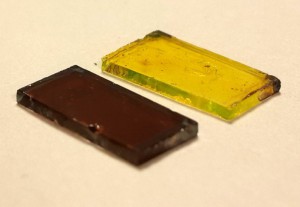According to researchers at Imperial College, London, the efficiency of perovskite cells has risen rapidly from less than four per cent in 2009 to over 20 per cent today, on par with traditional solar cells.
Solar cells using upstart ‘perovskite’ materials will be shipping in three years, according to the head of University of Oxford spin-out company, Oxford PV.
Photovoltaic perovskites were only invented recently.
“It is the fastest-improving solar cell material ever,” CEO Kevin Arthur told Electronics Weekly. “It has taken silicon 25 years to get to 20% efficiency. Perovskites go to similar efficiency in two years.”
It is thin-film technology where materials are coated on to sheets of glass, rather than expensively processed from mono-crystalline silicon wafers. Only tiny quantities of perovskite are required, and the raw materials are relatively cheap – no costly indium.
Efficient organometal halide perovskite-based photovoltaics were first demonstrated in 2012. They are now a very promising new material for solar cells as they combine high efficiency with low materials costs.
Last year, the University of Sheffield made perovskite solar cells by solution spraying.
The spray-painting process wastes very little of the perovskite material and can be scaled to high volume manufacturing – similar to applying paint to cars and graphic printing.
Lead researcher professor David Lidzey said: “Perovskite-based photovoltaics combine the high performance of mature solar cell technologies with the low embedded energy costs of production of organic photovoltaics.”
While most solar cells are manufactured using energy intensive materials like silicon, perovskites, by comparison, requires much less energy to make. By spray-painting the perovskite layer in air the team hopes the overall energy used to make a solar cell can be reduced further.
Lidzey adds: “The best certified efficiencies from organic solar cells are around 10%. Perovskite cells now have efficiencies of up to 19%. This is not so far behind that of silicon at 25% – the material that dominates the world-wide solar market.”
According to researchers at the Okinawa Institute of Science and Technology Graduate University (OIST), perovskite solar cells can be made cheaper by switching the construction from gold to silver electrodes.
 Electronics Weekly Electronics Design & Components Tech News
Electronics Weekly Electronics Design & Components Tech News





Thanks for your comment John, but ‘ouch’.
The life time of perovskite cells generally mentioned in our articles on them – try the links below.
However, every subject we write about could include an endless list of caveats, so we have to trust the readership – which is largely engineering professionals – to do their own due diligence.
Rest assured, we are not driving around in Ferraris paid for by evil international perovskite organisations.
http://www.electronicsweekly.com/news/products/led/perovskite-solar-cells-three-years-uk-inventions-2014-07/
http://www.electronicsweekly.com/news/research-news/cheaper-perovskite-solar-cells-need-fewer-pin-holes-2015-10/
http://www.electronicsweekly.com/news/research-news/oxford-removes-pb-perovskite-solar-cells-2-2014-05/
Strange – not one mention of the problem with their lifetime.
What happened to balanced reporting,nor is this a pure academic press release where they only give the positive spin and ignore the messy realities?
Regards – John